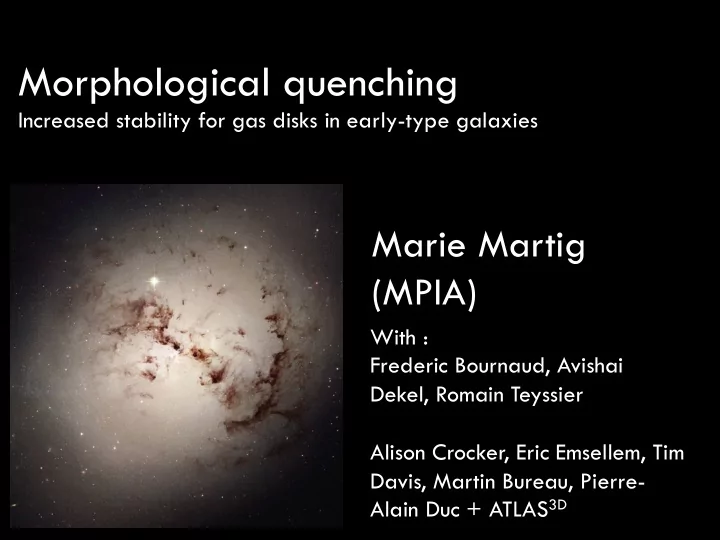

Morphological quenching Increased stability for gas disks in early-type galaxies Marie Martig (MPIA) With : Frederic Bournaud, Avishai Dekel, Romain Teyssier Alison Crocker, Eric Emsellem, Tim Davis, Martin Bureau, Pierre- Alain Duc + ATLAS 3D
Gas and star formation in early-type galaxies Young et al. 2011 . Small crosses are ATLAS 3D sample Figure 6. Molecular masses and M See also: Davis et al ATLAS 3D : volume limited sample of 26 local ETGs 2011a,b, 2013, 22% detection rate in CO ! Alatalo et al 2013
Gas and star formation in early-type galaxies Young et al. 2011 . Small crosses are ATLAS 3D sample Figure 6. Molecular masses and M ATLAS 3D : volume limited sample of 260 local ETGs 22% detection rate in CO !
Gas disk stability against local collapse and star formation ¨ Stability results from a competition between: ¤ self-gravity ¤ velocity dispersion which inhibits the collapse ¤ differential rotation that shears gas clouds ¨ Toomre parameter for a thin rotating gas disk: κσ g Q g = π G Σ g ¨ Stability criterion: Q g > 1 ¨ For a gas disk embedded in a stellar disk: an effective Toomre parameter (stars contribute to instability) Q = 1 1 + 1 Q g Q s
Gas disk stability in elliptical galaxies ¨ Gas disk is stabilized when stars are in a spheroid instead of a disk: ¤ steeper potential well ¤ reduced disk self-gravity ETGs should have lower star formation efficiencies: morphological quenching (Martig et al. 2009)
Morphological quenching in a cosmo simulation Elliptical galaxy with a massive gas disk but inefficient SF and red colors (Martig et al. 2009) MQ phase
Lower SF efficiency in elliptical galaxies
A comparison with high resolution AMR simulations ¨ AMR code RAMSES, 5 pc maximal resolution, star formation, kinetic SN feedback (Martig, Crocker et al. 2013) ¨ Same gas disk embedded in spiral or elliptical galaxy ¨ M gas =7.5 x 10 8 Msun, f gas =1.3% !""#$%#&'"()*+',-./01 ,$#2'"()*+',-./01 SFR = 0.1 Msun/yr SFR = 2.5 Msun/yr
A comparison with high resolution AMR simulations ¨ AMR code RAMSES, 5 pc maximal resolution, star formation, kinetic SN feedback ¨ Same gas disk embedded in spiral or elliptical galaxy ¨ M gas =2.5 x 10 9 Msun, f gas =4.5% !""#$%#&'"()*+',-3/41 ,$#2'"()*+',-3/41 SFR = 4.8 Msun/yr SFR = 11.3 Msun/yr
The resulting Kennicutt relation
Resolved observations of molecular gas and star formation in ETGs Name Distance H 2 mass CO maps : BIMA (Young et al. (Mpc) log( M � ) l 2008) and PdBI (Crocker et al. NGC 524 23.3 7.8 2009,2011) NGC 2768 21.8 7.8 HI mass: Westerbork (Serra et al. NGC 3032 21.4 8.7 NGC 4150 13.4 7.7 2012) NGC 4459 16.1 8.2 SFR maps: non-stellar 8 μ m NGC 4477 16.5 7.4 NGC 4526 16.4 8.8 emission (Shapiro et al. 2010) NGC 4550 15.5 6.9 +12 spirals with data from THINGS (Walter et al. 2008), BIMA-SONG (Helfer et al. 2003) and SINGS (Kennicutt et al. 2003) surveys
Observed ETGs have a lower star formation efficiency SF efficiency ~2 x lower (Martig, Crocker et al. 2013)
Also seen by the COLD GASS survey Saintonge et al 2012
Conclusion (1) ¨ Morphological quenching: gas disks are stabilized against star formation when embedded in a stellar spheroid instead of a disk ¨ Observational and numerical evidence for SF efficiency 2-5 times lower in ETGs ¨ Enough to make galaxies red ¨ Caveats: ¤ There is an upper limit to the amount of gas that can be stabilized ¤ Effect of mergers?
Conclusion (2) ¨ MQ could be in part why quenching and bulges are related (Bell et al. 2008, Lang et al. 2014, ...) ¨ Would make life easier for other mechanisms: no need to totally shut off gas accretion/cooling ¨ BUT we need molecular gas observations to prove MQ is occurring � � � � WE DO NOT MAKE PREDICTIONS FOR THE GAS CONTENT OF ETGs !!! If the morphological quenching scenario is correct, then at fixed stellar mass, we would expect to find higher average H i gas fractions for bulge-dominated galaxies on the red sequence than for disk-dominated galaxies on the red se- quence. (Fabello et al 2011)
Recommend
More recommend